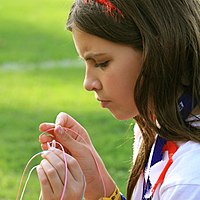
Photo from wikipedia
Rationale Theoretical models regarding the automaticity of attentional processes highlight a progression of attentional bias style from controlled to automatic in drinking populations as alcohol use progresses. Previous research has… Click to show full abstract
Rationale Theoretical models regarding the automaticity of attentional processes highlight a progression of attentional bias style from controlled to automatic in drinking populations as alcohol use progresses. Previous research has focused on older adolescent and adult drinking populations at later stages in their drinking career. Objectives The aim of this study was to investigate alcohol attention bias in 14–16-year-old adolescent social drinkers and abstainers. Methods Alcohol attention bias was measured in social drinking and abstaining groups in an eye-tracking paradigm. Questionnaires measured alcohol use, expectancies, exposure and socially desirable response styles. Results Social drinkers fixated to alcohol stimuli more frequently and spent a larger proportion of their fixation time attending to alcohol stimuli compared to non-drinkers. Groups displayed differences in their style of attentional processing of alcohol-related information, with heavy drinkers fixating significantly longer to alcohol information across alcohol stimulus presentation and exhibiting a delayed disengagement style of alcohol attention bias that differentiated them from light drinking and abstaining peers. All social drinkers fixated significantly more than abstainers in the latter half of alcohol stimulus presentation. Conclusion Alcohol attention bias was present in this adolescent sample. Drinking subgroups are defined from abstaining peers by unique features of their attentional bias that are controlled in nature. These findings are comparable to those in other adolescent and adult social drinking populations. The identification of specific attentional bias features according to drinking subpopulations has implications for our theoretical understanding of developing alcohol attention bias and problematic drinking behaviours, as well as at-risk identification and early intervention.
Journal Title: Psychopharmacology
Year Published: 2020
Link to full text (if available)
Share on Social Media: Sign Up to like & get
recommendations!